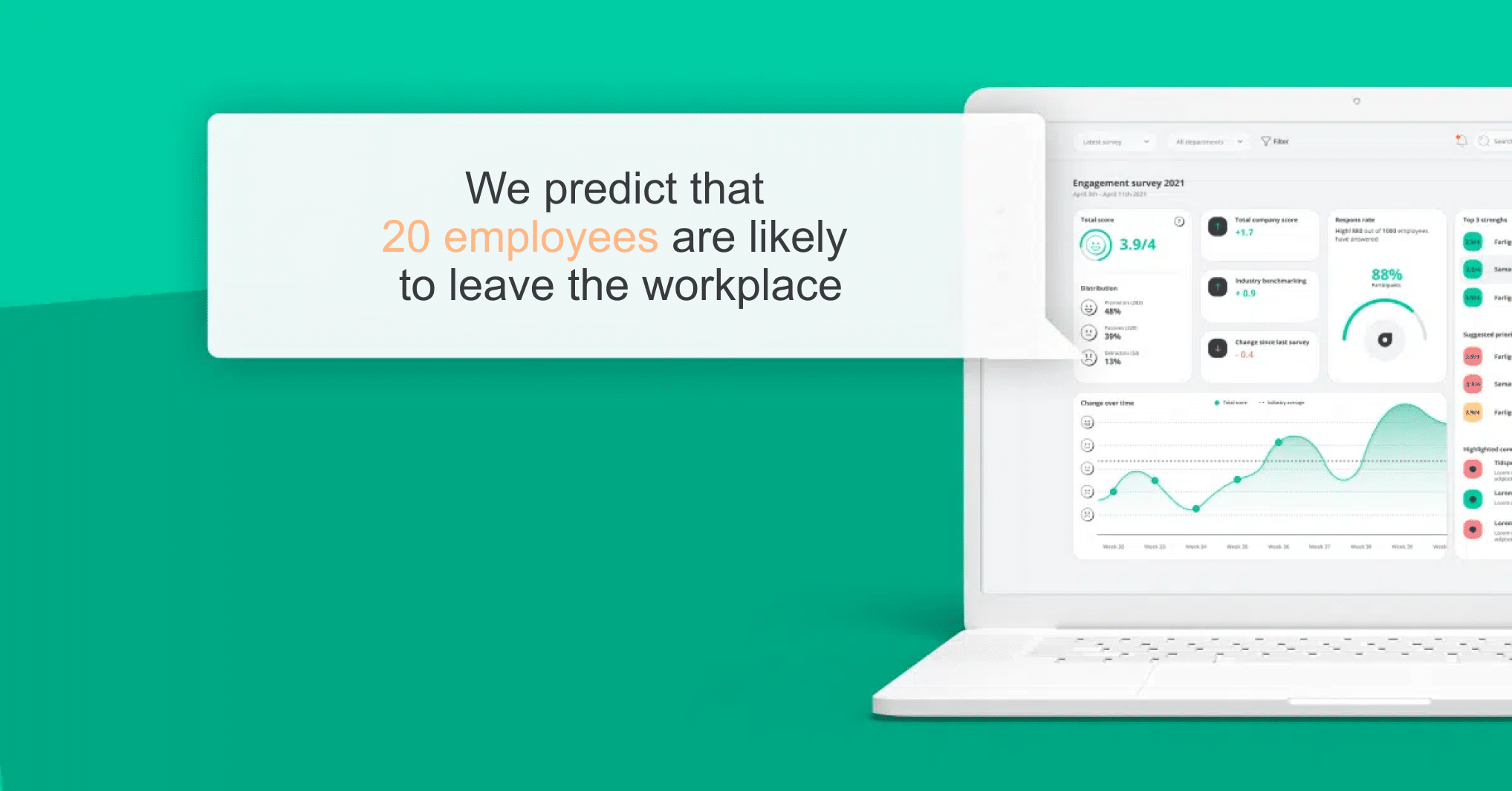What is the cost of losing an employee? If you’re asking this question, you’re not alone.
There is a really good reason to worry about this particular question – from the perspectives of both top management, HR and management. First, it is crucial for the financial health of companies to be able to attract and retain talent.
Several substantial surveys such as MIT’s newest ‘Toxic Culture Is Driving The Great Resignation’ reveal that currently more than 40% of all employees are contemplating leaving their job. Between April and September 2021, 24 million Americans left their job under the so called – ‘The Great Resignation’ – a phenomenon which has also started to reach Danish companies.
Losing an employee results in financial and operational consequences
Losing an employee comes with consequences for the workplace – both financially, culturally, socially and therefore for the entire work environment. The largest direct financial costs can be traced to the loss of production, recruitment and training of new staff in order to cover the human loss. Still, it is difficult to ascertain the exact loss. But some studies point out that every time a workplace loses a full-time employee, the cost is an average of 50% of the employee’s annual salary. However, this is merely the directly measurable costs. If you count the indirect costs in the form of lost production, cooperation difficulties and similar issues, the picture appears much scarier!
Having worked as HR Director for many years, I can say that, in HR, we know that losing an employee isn’t only about the money! Losing a great talent cannot only be traced in an Excel sheet, but has substantial consequences for the unity of the team in terms of cooperation, broken friendships and a psychologically bad work environment.
The most important metric for HR: employee turnover rate
In this connection, one metric speaks its own clear language when we want to know about employees’ well-being; the employee turnover rate – or simply: How many employees leave the company, and how quickly do they leave?
The most crucial metric for HR. Because it is costly to lose one’s employees. No question about it.
The employee turnover rate – or in other words attrition rate – of course varies from industry to industry. After The Great Resignation we call them the blue-collar and white-collar sector. Blue collar industries are some of the hardest industries to retain employees – retail, fast food and apparel. Where fx management consulting has one of the highest attrition rates.
However there is rarely a focus on what could be done to lose fewer employees. Even in companies with an employee churn in excess of 25%, information like this does not give rise to making a special effort.
And why is that? There are often two reasons.
One is that it doesn’t hurt enough.
The company and its employees manage to compensate for the large employee turn-over rate and reach their goals nonetheless.
It is off, all right, but not sufficiently off.
Another reason is that something inadvertently happens when you dive into the numbers. The focus of the discussion then shifts from a number reflecting a problem for the whole company to the individual employee.
”Hanne left, yes. But she had worked here for a long time…”
”So Peter left. But maybe it was time for him to try his hand at something new…”
”Well, Jakob left. He wasn’t exactly cut out for the job…”
The logic I have often witnessed is that it does not make sense to make company-related initiatives because the problem is the individual employee – not the company culture.
Recognisable?
But from my perspective, unwanted staff departure may be first and foremost an overlooked and expensive problem.
Luckily companies have an opportunity to measure the root causes of their employee turnover rates and forecast their top predictors before it happens. Let’s take a closer look.
How to make the change
And what does it take to change this individual and reactive approach? This is my suggestion: Take action in tree areas.
Use the employee engagement pulse surveys to measure the root causes of employee turnover rates
Find a digital system that can translate employee feedback into a forecast of your top predictors of employee turnover
Translate the results into action as fast as possible
This applies regardless of whether we are talking about the mandatory health and safety risk assessment, the employee engagement survey or the leadership evaluation. It is important to find a digital solution which doesn’t merely deliver data, but also gives you an idea of what the data means, and what actions you can take to proactively prevent loss of key employees. If you receive data only, much too often the result is talk and good intentions, without any real action or change.
A preventive effort throughout the company
It is also important not to play with closed cards within a narrow group consisting of HR and the company’s top management when it comes to data and insights from the measurements. If HR wants to create real change, the results must be put to work in all the company layers.
For these reasons, the best solutions go one step further and offer some good advice and recommendations as to how you may work with the work environment and employee engagement on the basis of the feedback from the surveys.
And the action plans must be implemented in all layers of the company – at the level of the employees, the teams, the management and the top management – so that you may work with prevention as a joint effort for the whole company.
Need help working proactively with employee feedback and data?
Predictive analytics – tomorrow’s HR
The few – but grey – hairs on my head may reveal that I have worked in the HR business for an unsaid number of years now. And, until recently, we have primarily worked reactively with our employee feedback.
Typically, the process has been like this:
Problems arise…..We collect feedback and discover the problems over several months.…We then correct the problems (mostly).
Our HR method has therefore been to look back at the data and feedback from various employee engagement surveys. In other words, we have had our backs against the future.
But what if we could look forward, having a sneak peek into the future – and predict employee turnover that hasn’t happened yet?
We can actually do this today using the ‘predictive people analytics’.
Predict and prevent employee turnover
As the name suggests, ’predictive analytics’ uses machine learning to predict the development and future results with the help of historic data. This gives HR and managers a real possibility of looking into the future where they can identify risks and prevent problems that haven’t happened yet – but will happen if we sit on our hands. The companies are simply given the ability to foresee potential problems and the loss of key employees before these problems arise.
And if you want to reach the very premier league of HR, there is no way around this.
’Predictive analytics’ is a big deal in HR data. And the possibility of putting it to work isn’t just a distant dream anymore, but the new reality that has come to stay.
In just five years, the number of HR professionals skilled at data analytics has risen 242% (LinkedIn 2020 Global Talent Trends).
And I am certain that ‘predictive people analytics’ will become a significant game changer for the whole of the HR industry, which will transform the way in which we work with employee turnover and attrition rates in HR.
Data-driven decision-making in HR
A game changer in the sense that it will enable HR to quantify the effects of their efforts! HR will find themselves able to deliver quantifiable financial gains from their employee engagement strategies with a whole new level of precision and speed than previously seen.
If HR succeeds in making this paradigmshift, companies will not only save an unimaginable amount of money – but will also save an incomprehensible number of people from losing their ability to work.
And that change is worth fighting for!
If you wish to learn more about the possibility of implementing ‘predictive people analytics’ with Woba, please contact me.












